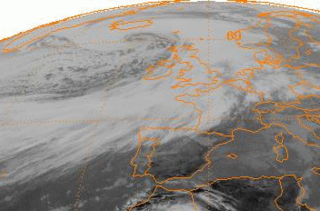
An adiabatic process is a type of thermodynamic process that occurs without transferring heat or mass between the thermodynamic system and its environment. Unlike an isothermal process, an adiabatic process transfers energy to the surroundings only as work. As a key concept in thermodynamics, the adiabatic process supports the theory that explains the first law of thermodynamics. The opposite term to "adiabatic" is diabatic.
English usually refers to:
The adiabatic theorem is a concept in quantum mechanics. Its original form, due to Max Born and Vladimir Fock (1928), was stated as follows:
Vibronic coupling in a molecule involves the interaction between electronic and nuclear vibrational motion. The term "vibronic" originates from the combination of the terms "vibrational" and "electronic", denoting the idea that in a molecule, vibrational and electronic interactions are interrelated and influence each other. The magnitude of vibronic coupling reflects the degree of such interrelation.
The diabatic representation as a mathematical tool for theoretical calculations of atomic collisions and of molecular interactions.
In fluid mechanics, potential vorticity (PV) is a quantity which is proportional to the dot product of vorticity and stratification. This quantity, following a parcel of air or water, can only be changed by diabatic or frictional processes. It is a useful concept for understanding the generation of vorticity in cyclogenesis, especially along the polar front, and in analyzing flow in the ocean.

Explosive cyclogenesis is the rapid deepening of an extratropical cyclonic low-pressure area. The change in pressure needed to classify something as explosive cyclogenesis is latitude dependent. For example, at 60° latitude, explosive cyclogenesis occurs if the central pressure decreases by 24 millibars (0.71 inHg) or more in 24 hours. This is a predominantly maritime, winter event, but also occurs in continental settings. This process is the extratropical equivalent of the tropical rapid deepening. Although their cyclogenesis is entirely different from that of tropical cyclones, bomb cyclones can produce winds of 74 to 95 mph, the same order as the first categories of the Saffir–Simpson scale, and yield heavy precipitation. Even though only a minority of bomb cyclones become this strong, some weaker ones can also cause significant damage.

Cold air damming, or CAD, is a meteorological phenomenon that involves a high-pressure system (anticyclone) accelerating equatorward east of a north-south oriented mountain range due to the formation of a barrier jet behind a cold front associated with the poleward portion of a split upper level trough. Initially, a high-pressure system moves poleward of a north-south mountain range. Once it sloshes over poleward and eastward of the range, the flow around the high banks up against the mountains, forming a barrier jet which funnels cool air down a stretch of land east of the mountains. The higher the mountain chain, the deeper the cold air mass becomes lodged to its east, and the greater impediment it is within the flow pattern and the more resistant it becomes to intrusions of milder air.

The rear-inflow jet is a component of bow echoes in a mesoscale convective system that aids in creating a stronger cold pool and downdraft. The jet forms as a response to a convective circulation having upshear tilt and horizontal pressure gradients. The cold pool that comes from the outflow of a storm forms an area of high pressure at the surface. In response to the surface high and warmer temperatures aloft due to convection, a mid-level mesolow forms behind the leading edge of the storm.

The Landau–Zener formula is an analytic solution to the equations of motion governing the transition dynamics of a two-state quantum system, with a time-dependent Hamiltonian varying such that the energy separation of the two states is a linear function of time. The formula, giving the probability of a diabatic transition between the two energy states, was published separately by Lev Landau, Clarence Zener, Ernst Stueckelberg, and Ettore Majorana, in 1932.
ECHAM is a general circulation model (GCM) developed by the Max Planck Institute for Meteorology, one of the research organisations of the Max Planck Society. It was created by modifying global forecast models developed by ECMWF to be used for climate research. The model was given its name as a combination of its origin and the place of development of its parameterisation package, Hamburg. The default configuration of the model resolves the atmosphere up to 10 hPa, but it can be reconfigured to 0.01 hPa for use in studying the stratosphere and lower mesosphere.
Peter Howard Haynes is a British applied mathematician in the Faculty of Mathematics at the University of Cambridge. He is a Fellow of Queens' College, Cambridge and served as Head of the Department of Applied Mathematics and Theoretical Physics (DAMTP) from 2005 to 2015.
In chemistry, the selection rule formally restricts certain reactions, known as spin-forbidden reactions, from occurring due to a required change between two differing quantum states. When a reactant exists in one spin state and the product exists in a different spin state, the corresponding reaction will have an increased activation energy when compared to a similar reaction in which the spin states of the reactant and product are isomorphic. As a result of this increased activation energy, a decreased rate of reaction is observed.
Modern synthesis or modern evolutionary synthesis refers to several perspectives on evolutionary biology, namely:

Michael Edgeworth McIntyre FRS is a mathematician and Professor Emeritus of Atmospheric Dynamics.

WISE 0825+2805 is a (sub-)brown dwarf with a spectral type of Y0.5. It is about 21.4 light-years away from Earth in the Cancer constellation.
This page is based on this
Wikipedia article Text is available under the
CC BY-SA 4.0 license; additional terms may apply.
Images, videos and audio are available under their respective licenses.






